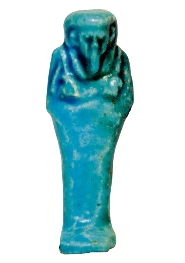

|
|
|||||||||||||||||||||
|
2181 BC
|
2040
|
1782
|
1570
|
1070
|
525
|
332
|
30 BC
|
|
|||||||||||||
|
|
|||||||||||||||||||||
|
|
|
||||||||||||||||||||
|
|
|||||||||||||||||||||
|
|
|||||||||||||||||||||
|
Ptolemaic Period
During the Ptolemaic Period (330-30 BC) funerary statuettes became less
well made before disappearing altogether as religious ideology began to change.
A typical example is shown here
(1).
In general, shabtis of this period are rudimentary in their execution and are often uninscribed.
In addition to crude faience examples, bi-chrome glazed faience shabtis are found during this period after being introduced during the 30th Dynasty
although examples also existed at earlier times too. These are characterised by
having wigs and sometimes the inscription in a darker blue than the rest of the
figure. The glaze is often thickly applied. Inscriptions on Ptolemaic Period
shabtis are often full of errors.
|
|
||||||||||||||||||||
|
|
|||||||||||||||||||||
|
1. Faience anonymous ushebti
Late Period, 30th Dynasty - Ptolemaic Period c. 380-30 BC
|
|
||||||||||||||||||||
|
|
|||||||||||||||||||||
|
|
|
|
|
|
|
|
|
|
|
|
|
|
|
|
|
|
|
|
|
|
|




























